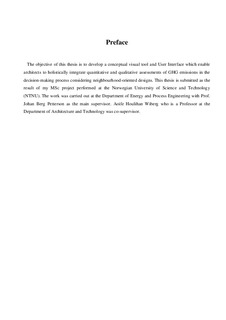| dc.description.abstract | Building, transportation, and human activities are main sources to generate greenhouse gas (GHG) emissions in neighbourhood. In order to reduce GHG emissions in neighbourhoods, architects plays an important role particularly in the early design phase since this is when the architect has the greatest opportunity to make design decisions that directly lead to a reduction in the GHG associated with the consumption of energy and embodied emissions of materials used in zero emission neighbourhoods. However, it is not easy for architects to easily understand and visualise how their design contributes to the overall GHG emissions for the neighbourhood since the origin of the emission is out of architectural scope. Thus, this thesis develops a tool visualizing the relationship between the neighbourhood design and GHG emissions, which can be easily utilized by architects.
This thesis is aligned with the Research centre on Zero Emission Neighbourhoods in Smart Cities (FME-ZEN). A ZEN is defined as a group of interconnected buildings with associated infrastructure, located within a confined geographical area, aiming at reducing its direct and indirect greenhouse gas (GHG) emissions towards zero. Life cycle assessment (LCA) is used to estimate the potential environmental impacts of a product or service system throughout its life cycle. The methodology was initially developed and used for zero emission buildings and has now been expanded to include zero emission neighbourhoods (ZENs).
The FME-ZEN research centre has already developed a set of ZEN assessment criteria and key performance indicators (KPIs) that can quantify and qualify neighbourhood performance. This work defined the new criteria and indicators based on KPIs of ZEN and other assessment tools in order to apply to the visual tool developed in this work.
The main objective of this thesis is to develop a conceptual visual tool and User Interface which enable architects to holistically integrate quantitative and qualitative assessments of GHG emissions in the decision-making process considering neighbourhood-oriented designs based on the ZEN KPIs. The visual tool was developed in main two platforms (small-neighbourhood platform and large-neighbourhood platform). The small-neighbourhood platform visualises building energy performance and the GHG emissions as a quantitative assessment tool while the large-neighbourhood platform displays urban information related with the emissions as a qualitative assessment tool. The platforms of this thesis as a conceptual assessment tool do not develop the actual interconnection with the computing tools for the GHG emission assessment. However, as one of the contributions of this thesis, proper tools and database are selected and their detailed connection plan is established for practical use of the dashboard in near future.
Through the case study of Nidarvoll Skole in Trondheim region of Norway, this thesis shows how the new school design is associated with GHG emissions and how the relationships can be effectively visualised to help the decision-making process for architectural design toward zero-emission neighbourhoods. By using the visual tool developed in this thesis, the most environmentally friendly design option was able to be selected, which delivers less energy consumption and CO2 emission, compared to the original school design. The savings in the two KPIs reached to 20,508 kWh/yr and 1,871 kgCO2eq/yr respectively, compared to other design options. | |
